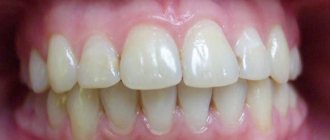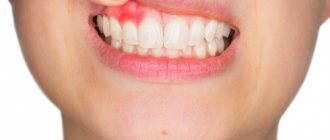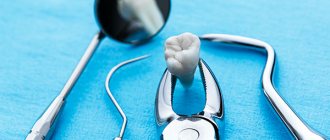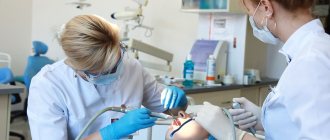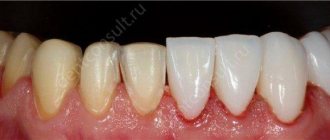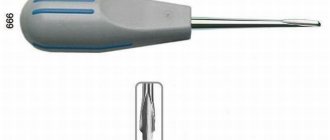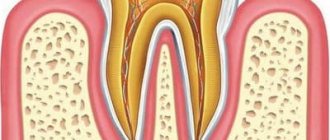Features of tooth extraction in the upper jaw
Unlike lower “eights,” upper wisdom teeth are considered less problematic. They tend to grow straighter, have less retention, and rarely have roots that are bent, twisted, or excessively long. The bone of the upper jaw is not so massive and dense, there are fewer blood vessels in the soft tissues, and the likelihood of hitting the trigeminal nerve is lower. Therefore, the upper wisdom teeth rarely have to be removed, and if it comes to surgery, it is easier than removing the lower wisdom tooth.
Simple removal of the top eight
Simple is the removal of the upper wisdom tooth, which does not require preliminary dissection of the gums. This is how molars are removed that have erupted without pathologies and have small, even roots. Simple removal is carried out in 4 stages.
- The doctor conducts a diagnosis
- takes an X-ray or CT scan, assessing the position of the tooth and the structure of the root system. - The patient receives pain relief.
Removal of the upper “eight” is usually performed under local anesthesia. - The doctor places forceps on the crown of the tooth and performs luxation and traction
- he rocks the tooth and pulls it out of the socket. - The hole is treated with an antiseptic and, if necessary, sutured.
Read more about the operation in a separate article.
Indications and contraindications
Diagnosis of a complicated condition can also be characterized by associated negative factors, such as:
- The formation of tumors and edema, causing pain in the patient and affecting the structure of mucous tissues;
- Loss of sensitivity of the facial nerve endings caused by internal damage caused by the unnatural position of the root part;
- High probability of displacement or rotation of adjacent units in contact with the problem tooth;
- Diagnosis of pathological processes, the occurrence and development of which is caused by deviation of the alveolar position.
The price for removing a complex tooth in dental clinics in St. Petersburg also depends on the presence of medical contraindications that complicate or exclude surgical intervention. Limiting factors primarily include cardiovascular pathologies, insufficient blood clotting, a history of hypertensive crisis, acute forms of chronic and infectious diseases, as well as other manifestations that require additional treatment or the choice of an alternative method of recovery.
Complex removal of a wisdom tooth in the upper jaw
A complex operation involves additional manipulations to extract a molar: cutting the gum, sawing the crown, extracting the tooth in parts. This is how impacted, semi-impacted and dystopic teeth are removed. The percentage of complex operations when removing the top eight is small, but sometimes they still have to be performed. Here's how it happens.
- As with a simple operation, an X-ray
or
CT
, otherwise there is a chance that the operation will be performed poorly. - The doctor numbs the gum.
In the most severe cases, removal of the upper wisdom tooth can be performed in a hospital setting under general anesthesia, but anesthetic injections are more often used. - An incision
is made , the mucous flap is peeled off, and access to the crown is opened. - The doctor begins to extract the molar
. Complex teeth often have to be removed piece by piece, carefully cutting them with a drill. Sometimes they even cut down a section of the jawbone to gain access to the roots. - After the tooth is removed, the doctor checks the socket for the presence of bone fragments, treats the wound and sutures the gum. If there has been a resection of the jawbone, then osteoplasty
- the hole is filled with bone chips, which over time will form new bone tissue to replace the removed one.
After a complex wisdom tooth extraction, the patient should prepare for a long rehabilitation: the wound can take up to several weeks to heal.
Use of anesthesia
Tooth extraction, like any other operation, is performed with the use of painkillers. Most often, local injection anesthesia is used: the doctor injects an anesthetic directly into the gum, and within 3-5 minutes it completely loses sensitivity. To properly numb the surgical site, two injections are required - into the outer and inner parts of the gums. The use of local anesthesia is possible on an outpatient basis; after the operation, the patient can go home.
But sometimes the “eights” have to be removed under general anesthesia. It is usually used if the case is complex and a long operation is required, or several teeth need to be removed, or if the patient is experiencing psychological difficulties. General anesthesia requires hospital conditions, and its price is much higher.
Indications for removal of lower teeth
Conventionally, all indications for surgical intervention in the lower jaw can be divided into groups:
- Chronic intoxication resulting from advanced dental disease. It can lead to sepsis, myocarditis, endocarditis and other dangerous connective tissue lesions.
- Purulent processes in the periodontium, if they cannot be stopped using conservative methods.
- Acute osteomyelitis, perimaxillary abscess, phlegmon, sinusitis caused by a destroyed tooth. Extraction is carried out only if the disease cannot be eliminated by therapeutic methods.
- Longitudinal fracture, splitting of the crown into 2-3 parts with exposure of deep layers of the pulp (if it is impossible to close the defect with filling material).
- The presence of units that are positioned incorrectly and injure the surrounding mucous membranes, but are not subject to orthodontic treatment.
- Detection of elements that have not fully erupted, causing inflammatory reactions in adjacent areas.
- To eliminate malocclusions before starting an orthodontic course.
- The presence of supernumerary lower units that interfere with proper oral hygiene, prosthetics, disrupt chewing function, or cause constant pain.
Is it painful to remove an upper wisdom tooth?
Based on patient reviews, we can conclude that what scares them most about the operation of removing the upper “eights” is pain. But you shouldn’t be afraid of it: modern anesthetics completely block unpleasant sensations. Even if one of the drugs did not provide high-quality pain relief, the doctor will always be able to choose another one. There is no need to endure pain during wisdom teeth removal!
Most often, patients complain of pain not during, but after surgery. This is quite predictable: the anesthesia wears off and the body “remembers” the wound in the mouth. To relieve pain during the rehabilitation period, the doctor prescribes painkillers to the patient. With a simple removal of a wisdom tooth from above, 1-2 appointments may be enough, but after a complex operation, you will have to take pills for several days.
Types of anesthetics
Removal of a molar tooth with an injection involves several types of pain relief; the choice is made by the doctor, depending on the location of the molar, the degree of tissue destruction, the expected time of extraction and other factors:
Pain reliever for tooth extraction
- Applique. This type of anesthesia is used mainly if the patient is afraid of pain from the injection of an injectable anesthetic, as well as when tartar or baby teeth are removed from a child. A special gel or spray is applied to the gum area near the molar.
- Infiltration. This type of anesthesia involves two injections of a substance, from the side of the palate and the lip, the medicine is injected into the apex of the root through the gum. Freezing begins within two minutes after the injections and lasts for another hour after the end of the extraction procedure. Infiltration anesthesia is good because the patient does not feel pain, and there is no numbness in most of the face.
- Conductor. Such anesthesia is necessary when removing wisdom teeth and molars. An injection is made in the area of the trigeminal nerve, as a result of which the sensitivity of a large part of the face is blocked, and numbness persists after extraction for another 1.5–2 hours.
- Intraligamentary. The patient receives an injection into the periodontal fissure, it is carried out under more powerful pressure. The medicinal substance is located inside the bone tissue of the alveolar process, due to which the effect occurs instantly, but lasts about 30 minutes.
- Stem. This type of anesthesia involves serious maxillary surgical interventions; the branches of the maxillary and mandibular nerves are blocked. The injection is injected into the lower edge of the cheekbone, a pronounced freezing effect begins after 10 minutes.
- Sedation. With this type of anesthesia, the patient is depressed or asleep (with deep sedation). The superficial type of such anesthesia allows a person to respond to the doctor’s voice and follow his commands, swallow saliva, open his mouth, while the patient is relaxed and does not feel any discomfort. The medicine is administered through a mask or injected into a vein.
In especially severe cases, when extensive surgery is required, the patient is allergic to other types of anesthesia, or is simply panicky about the extraction procedure, doctors use general anesthesia. However, this method is used extremely rarely, since general anesthesia requires intervention in a hospital setting and under the strict supervision of an anesthesiologist.
In modern dentistry, carpules are used for pain relief; they are in disposable capsules inserted into a metal syringe, then a thin needle is screwed onto it.
At the same time, the medicine remains sterile, it does not need to be opened, and it does not come into contact with air when drawn into a syringe. The thinnest needle ensures minimal discomfort when administering the drug. The following modern anesthetics are used for extraction:
- Articaine is an anesthetic drug that is used in conduction and infiltration anesthesia, when it is necessary to remove several molars in a row;
- Scandonest is a drug contraindicated in adolescents under 15 years of age and elderly patients, as well as people with diabetes, kidney, liver and heart diseases;
- Septanset is a medicine that contains an anesthetic and adrenaline, it is used for the removal of molars, long-term treatment and when cleaning the roots of teeth.
Modern drugs rarely cause allergies, but if a person has a predisposition, he should definitely notify the dentist about this in order to avoid unforeseen situations.
Possible complications
The structural features of wisdom teeth determine the possibility of surgical and postoperative complications - this is another reason for patients to be concerned about the removal of wisdom teeth. Fortunately, they are quite rare and in most cases are associated with insufficient professionalism of the doctor. If the surgeon acts carefully, then unpleasant consequences can be avoided. However, it is worth knowing what you might encounter.
- Tooth destruction during the extraction process.
This can happen if the integrity of the enamel is damaged by caries, and the doctor presses too hard on the forceps. It is accompanied by a characteristic cracking sound and can greatly frighten the patient. Requires careful removal of fragments from the hole. - Fracture of the jaw bone.
This is also a consequence of the rough work of the surgeon, who, by applying forceps, can capture part of the alveolar process along with the tooth. - Alveolitis.
This is inflammation of the socket, accompanied by swelling, pain, fever and bad breath. Requires immediate sanitation of the wound surface and antibiotics. - Damage to the maxillary sinus.
A rare but very dangerous complication when perforation of the wall of the maxillary sinus occurs. To avoid this, the doctor should carefully study the x-ray and act as carefully as possible.
Pain after removal
Since molar removal is still a surgical operation, albeit on a small scale, complications sometimes arise after it, including bleeding, inflammation of the gums, and loss of sensitivity. If the extraction went without complications, slight pain may be observed for 2-3 days after the intervention. There is nothing wrong with this; cool compresses help relieve swelling of the tissues; they are applied for 10–15 minutes.
To make the healing process of the hole more comfortable, the patient should follow the following recommendations:
- do not eat food immediately after extraction for 2–3 hours;
- make cool compresses 3-4 times a day, applying them to the painful and swollen area;
- do not visit places where the air temperature is too high or low and, moreover, do not allow sudden temperature changes;
- do not rinse the mouth on the first day so that a blood clot forms at the bottom of the hole - it is necessary to protect the wound from infection;
- in the absence of swelling and fever, you can relieve pain by taking Analgin, Baralgin or Ketorol tablets;
- give preference to soft food in the first two days after extraction;
- Do not drink carbonated drinks, spicy and sour foods.
If acute pain is accompanied by a rise in temperature and a sharp deterioration in well-being, you should not delay a second visit to the doctor - most likely, an infection has entered the hole or a small fragment of a tooth root remains there. Only a dentist can determine the cause of the ailment and solve the problem. The intensity of pain during extraction is the result not only of the anesthetic used, but also of the psychological state of the patient himself.
A problem-free procedure also depends on which teeth are being removed, whether there is an inflammatory process in the oral cavity, and whether the roots are large and thick. But in most cases, patients who were initially terrified of having their molars pulled out say goodbye to this problem forever, since modern dentistry allows extraction to be carried out absolutely painlessly and comfortably for the person.
Recovery period
How long does recovery take after removal of upper wisdom teeth and what limitations does it impose? In most cases, after 1-2 days the patient returns to normal life, but sometimes recovery takes longer. To prevent the rehabilitation period from being prolonged, it is very important to follow the doctor’s recommendations:
- take prescribed antibiotics, painkillers and anti-inflammatory drugs;
- do not visit the bathhouse, sauna, swimming pool, or take a bath;
- follow a diet, if possible, eat only soft foods;
- refrain from smoking.
If the doctor did not make mistakes during removal, and the patient carefully followed all the doctor’s recommendations, then the recovery period will pass quickly, and the problem of the upper “eights” can be forgotten forever.
